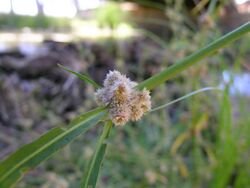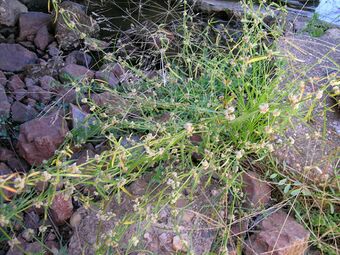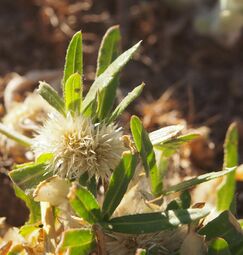Biology:Alternanthera nodiflora
| Alternanthera nodiflora | |
|---|---|

| |
| Scientific classification | |
| Kingdom: | Plantae |
| Clade: | Tracheophytes |
| Clade: | Angiosperms |
| Clade: | Eudicots |
| Order: | Caryophyllales |
| Family: | Amaranthaceae |
| Genus: | Alternanthera |
| Species: | A. nodiflora
|
| Binomial name | |
| Alternanthera nodiflora | |
| Synonyms[3] | |
|
Alternanthera nodiflora var. linearifolia Moq. | |
Alternanthera nodiflora (common name common joyweed)[4] is a species of flowering plant in the family Amaranthaceae.[1][2] It is endemic to Australia , growing in all mainland states.[4] It is naturalised in Tasmania, over much of Africa, in Japan , and in Myanmar.[5]
Description
Alternanthera nodiflora is an erect annual herb. The branches are almost without a covering but the nodes are covered with dense intertwined hairs, and there are two lines of hairs along the branches. The leaves, too, are almost without a covering and are linear, 2-8 cm long and have smooth margins. The inflorescences are globular, and often clustered. The fruit is less than half the length of the perianth. The style is very short.[6]
Taxonomy and naming
It was first described by Robert Brown in 1810.[1][2] The type specimen is BM001015779 (collected on the east coast of Australia); Isotypes are E00279928 (collected at Broadsound), P00622600 (all three collected by Brown). The name is accepted by the Council of Heads of Australasian Herbaria,[1] by Plants of the World online,[5] but is considered a synonym of Alternanthera sessilis by Catalogue of Life.[7]
The specific epithet, nodiflora, derives from the Latin, nodus,( "knot" or "node") and flos, floris ("flower") to give an adjective describing the plant as having flowers arranged in a knot-shaped inflorescence or flowering at the nodes.[8]
Gallery
References
- ↑ 1.0 1.1 1.2 1.3 "Alternanthera nodiflora". Australian Plant Name Index (APNI), IBIS database. Centre for Plant Biodiversity Research, Australian Government. https://biodiversity.org.au/nsl/services/rest/name/apni/84268.
- ↑ 2.0 2.1 2.2 Brown, R. (1810). Prodromus florae Novae Hollandiae et insulae Van-Diemen, exhibens characteres plantarum quas annis 1802-1805. pp. 417. https://www.biodiversitylibrary.org/page/6157509.
- ↑ "Alternanthera nodiflora R.Br.". Australian Plant Census (APC). https://biodiversity.org.au/nsl/services/search?product=APC&tree.id=51209179&name=Alternanthera+nodiflora+R.Br.&inc._scientific=&inc.scientific=on&inc._cultivar=&max=100&display=apc&search=true. Retrieved 2020-05-23.
- ↑ 4.0 4.1 S. W. L. Jacobs & L. Lapinpuro (1990). "Alternanthera nodiflor R.Br.". National Herbarium of NSW. http://plantnet.rbgsyd.nsw.gov.au/cgi-bin/NSWfl.pl?page=nswfl&lvl=sp&name=Alternanthera~nodiflora. Retrieved 2020-05-23.
- ↑ 5.0 5.1 "Alternanthera nodiflora R.Br. | Plants of the World Online | Kew Science". http://powo.science.kew.org/taxon/urn:lsid:ipni.org:names:59266-1.
- ↑ "Fact sheet for Alternanthera nodiflora". http://www.flora.sa.gov.au/cgi-bin/speciesfacts_display.cgi?form=speciesfacts&name=Alternanthera_nodiflora.
- ↑ "Catalogue of Life: Alternanthera nodiflora". http://www.catalogueoflife.org/col/search/all/key/Alternanthera+nodiflora.
- ↑ "nodiflorus,-a,-um". http://www.plantillustrations.org/epithet.php?id_epithet=205238%3C/div%3E%3Cdiv%20class=.
External links
Wikidata ☰ Q22111965 entry
 |



